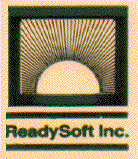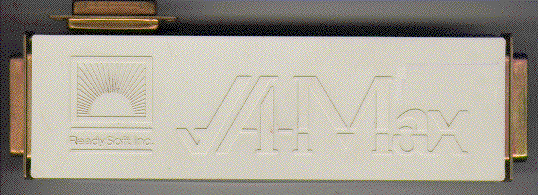A-Max was written by Simon Douglas,
and the A-Max cartridge was designed by David Foster and Don Holtz.
Thanks also to Jorge Freitas for the Preferences graphics.
(Above message is displayed by clicking the A-Max symbol in 1.0 or 2.0)
This appears to be the history of it:
v1.0 in 1989 (Cartridge only) System -> 6.0.3
v2.0 in 1990 (Cartridge only) System -> 6.0.8
v2.5 in 1992 Both Cartridge Module & Plus Board supported. System 6/7.
v4.0 in 1993 (Readysoft/PiHa) The Cartridge Module was not supported.
II+ Board only. System 7 only. Hardfiles, good use of SCSI.
Readysoft A-Max: The Hardware
A-Max has been available since 1989 (though now only used), in 2 flavors:
1. As An External tan colored module that plugs into the Amiga Floppy drive
port. This shipped with A-Max 1.0, 2.0x, and A-Max 2.5x. The outside
of the module has a large A-MAX Symbol and the Readysoft, Inc. sunrise
in a square symbol. The inside has minor circuitry, 2 ROM sockets,
and the signatures of the A-Max designers on the inside of the
plastic case. These designers were: Simon M. Douglas (Software)
David Foster and Don Holtz (Hardware).
The Emplant had similar modules; Amia and Sybil could be used...and they MIGHT
be somewhat A-Max compatable.


2. As a plug in ZORRO card (A2000, 3000, 4000 etc.) It appears the card was
originally made for The A2000 and A-Max II v2.5, but it is appearantly
is the same card for A-Max IV. A-Max II when shipped with the Zorro
card was called A-Max II Plus.
It allowed for direct hardware accesses for Appletalk and MIDI
with a special cable and a switch on the back of the A-Max Card.
It also allows reading of Mac Disks from normal Amiga drives!!
Nice timing ratio conversion there guys!!!
The A-Max IV package has an updated chip. (IC5) a GAL programmable
logic chip. (Why? I am assuming to use the floppy drives differently
with AmigaDOS in A-Max IV.)
I was told G revision is A-Max II and H revision is A-Max IV.
IC5 (20 pin) is the one to change, and Mine have M5F AMAXn-G "n" being 1-6
IC5 would be "1" and the "G" or "H" is scratched out, so I don't know.
IC5 is a GAL (General Array Logic); like a programmeble gate (AND/OR/etc.)
Please Send me your IC5 ID numbers and A-Max versions if you can, folks!
(See TEST Page)

I wish I could just make mine work; I need to know if the floppy
ribbon cables supplied have twists in them, and where...I'm using
no-twist cables the Amiga drives work, but A-Max and Mac disks are
software ejected. If I unplug the card, leaving floppy cables
connected, the A-Max disks work... (No power or control to the board)
Maybe my card is bad, or maybe it's the GALs (IC5) was designed for
A-Max IV which won't work with a 68000...And A-Max 2.5 won't work
with the A-Max IV GAL...see the test page for what I learn...
Readysoft A-Max Verbose History
1989 Version 1.0 Designed for A500, A1000, A2000. Came with the A-Max
cartridge, A-Max Program disk, Utility disk, Manual & Registration.
Mac ROMs not included.
- Workbench 1.3 & bootable Floppy Based
- Uses Apple 64K or 128K Roms from Old Macs...
( Mac 128K, 512K, 512Ke, & Mac Plus )
- Tested to Macintosh System 6.0.2 by Readysoft.
- Tested to Macintosh System 6.0.3 By Reginal Cross
- Works up to system 6.0.3. Newer systems lock & Flash on bootup.
- Imagewriter to Epson 9-Pin conversion for printing!
- No LaserWriter support, though. (No Postscript.)
- The "Disk Transfer" utility is on the A-Max "Utilities" disk &
invisible to Amiga Drive. Only a real Mac Drive will see it.
Format & Copy files from a real MAC to an A-Max/Amiga readable
272K Floppy Mini Transfer Disk - copy files or disks with them.
(Formattable on Mac Variable speed drive only. See 1.0 docs)
- Will not Run any Mac II or System 7 software; Mac II uses 256K+ ROMs
- The system 'bell' is the ONLY sound supported.
- Clock support only for 500/2000
- 3 Amiga low density floppy Drives & 1 Mac Drive supported.
Tested: Excel 1.5, Word 4.0, Hypercard 1.2, Pagemaker 2.0,
Smartcomm II (AmigaWorld Oct89)
1990 Version 2.0 (First in A-Max II "Macintosh II" series)
Supported New ECS modes, WB 2.0, SCSI, and HDD Partitions!
- Tested successfully to System 6.0.8 By Reginal Cross.
- Time Clock enhancements.
- Playing Digitized Sound Support.
- Support for ECS Chip set (New screen modes!) & WB 2.0
- Support for Memory Management Units (MMUs) on accellerators
- Simplified A-Max to AmigaDOS transfer utilities.
- Support for A-Max partitions on selected Amiga Hard disks.
- Support external SCSI input. storage, and output devices.
- More Screen modes.
- Cartridge based. Only an upgrade from 1.0 as far as I know.
1992 Version 2.5 (A4000 Support) Readysoft tested to System 7.0.
- Either Cartridge or A-Max II+ card versions.
- 128K ROMs from Mac Plus or 512Ke ONLY! No 64K ROMs
- Startup / Memory / SCSI preferences interface greatly enhanced.
- Support for 2048 x 2048 virtual scrolling screen.
- File transfer to a AmigaDOS FFS Partition! ****
- Extended keyboard now emulated.
- C= 1.76 MB Drive support; (Superdrive Emulation) Reads 1.44MB disks!
- Parameter RAM saved as a file on Boot disk.
- "Auto" switch for cli startup.
- Versions 2.50, 2.51, 2.53 are Official releases.
- Very Stable on My A1200 / 030 & OS 6.0.8.
The distribution called "A-Max II Plus" included a Zorro card
instead of the cartridge, which supported Appletalk, and MIDI
for better compatibility, and allows reading of Mac formatted
disks on Amiga drives (A-Max Zorro card has a hardware patch!)
A-Max 2.5 has A1200 version, also. (No Zorro Board w/o Tower)

1993 Version 4 Distributed by Readyoft/PiHa dated 1993,
- Finally it was MULTITASKING!!!! and claiming "Quadra emulation"
- Uses System 7 ONLY. Requires 68020+ / WB 2.1+ (CrossDOS / Filereq)
- Color!!!!!
- Multible screen support (Multiple screens different screenmodes)
- It is reported to run up to SYSTEM 7.1.1+.
- Hardfiles and device disks now supported!!!
(Appears to be identical to Shapeshifter's)
- Allows transfer of Mac Disks to disk image files - mountable on bootup.
- No Cartridge support. (See A-Max Test page for hack)
- 128K ROMs only. (Mac Plus / 512Ke) (Patches on bootup)
- It Has A-MaxInit (execute after setpatch in startup-seq) instead of
PrepareEmul (Like SS)
- PiHa was a company owned by Simon Douglas, possibly created for legal
or copyright reasons... I don't know, and probably never will...
There were many minor releases, and I will try to list them as I find out
more on them...
Actual confirmed interim versions: (.dms's sent & verified)
2.51, 2.53
Tha last official version was A-Max IV version v4.008.
Unofficial until I confirm:
2.05
2.06 (Unconfirmed-from FastAmax)
2.56 (Quartex hack only?)
- VERY STABLE on my A1200/030.
I have heard of numerous other releases as well...
A few of the A-Max hacks:
Cracks:
????? AMAX 1.0
Capn' Crunch AMAX 2.0 (A-Max II)
Quartex: AMAX 2.5
???? AMAX 4.0 ????
Credits:
Software: Simon Douglas
Cartridge: Don Holtz and David Foster
Plus Card: Ralph & Gunther Doewich of Cybercube Research Ltd.
A-Max 1 & 2.0 Graphics & Logo: Jorge Freitas
1.0 Guide: ??? Probably Simon Douglas...
2.0 Guide: ??? My docs are too limited...
2.5 Guide: Gary Gehman & Simon Douglas
IV Guide: Bob Eller & Jim Meyer
[23 August 99]
The following was written to me, but likely is of interest to all:

At the beginning of 1996, Malofilm Communications broadened its activities
into interactive development and publishing with the acquisition of
Toronto-based ReadySoft, Quebec City-based Megatoon Studios, and
Montreal-based MMI MultiMedia Interactif. Since the integration of these
three acquisitions, Malofilm has announced a series of reorganizational
measures modifying the Interactive division's structure. Malofilm's
reorganization includes a name change that will allow us to focus on
recentering our strengths and redeploying our resources internationally
under the banner Behaviour Communications. Malofilm Interactive (soon to
become Behaviour Interactive) has completed its reorganization and is now
ready to pursue its continued growth.
Please note that as a result of its restructuring, Malofilm is no longer
developing nor distributing ReadySoft products (Brain Dead 13, Dragon's
Lair II, Time Warp, Space Ace, Dragon's Lair, Guy Spy and Wrath of the
Demon) - exception made of Silmarils titles Time Warriors and Deus, and
Windy Hill's Menlo the Frog. While having ceased all activities in the
Toronto unit and integrated ReadySoft's sales force and distribution
network within the new entity.
That is the story, so in regards of legal rights to use A-Max or support it
there is no problems for you to do so because we don't have any legal trace
of it. - [Note: 'do so' = freely distribute A-Max]
Jean Maurice Duplessis
Vice President, Acquisitions and Special Projects
Malofilm Interactive (soon Behaviour)
Montreal, Canada

Regarding Contacts:

Please click HERE to go back to the A-Max Home Page.
Please send comments to A-Max Tech Support (On A-Max Home Page)